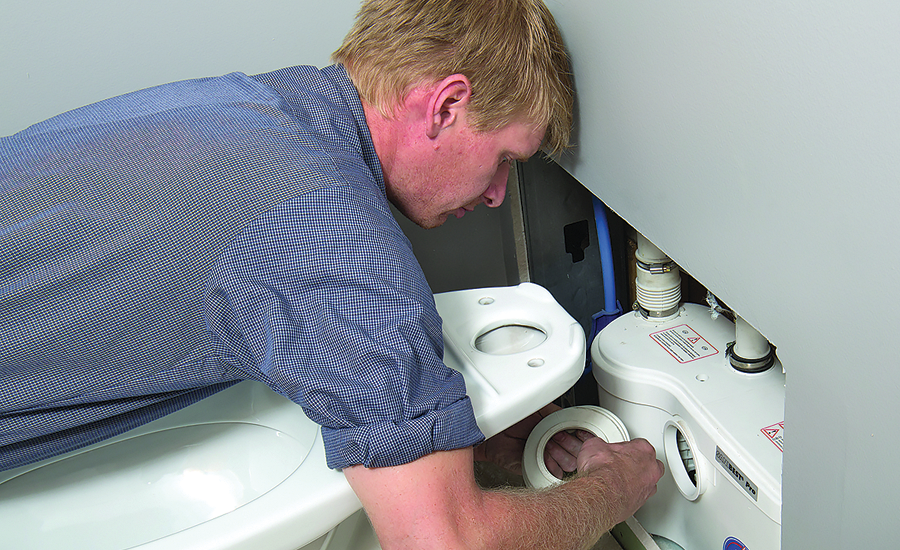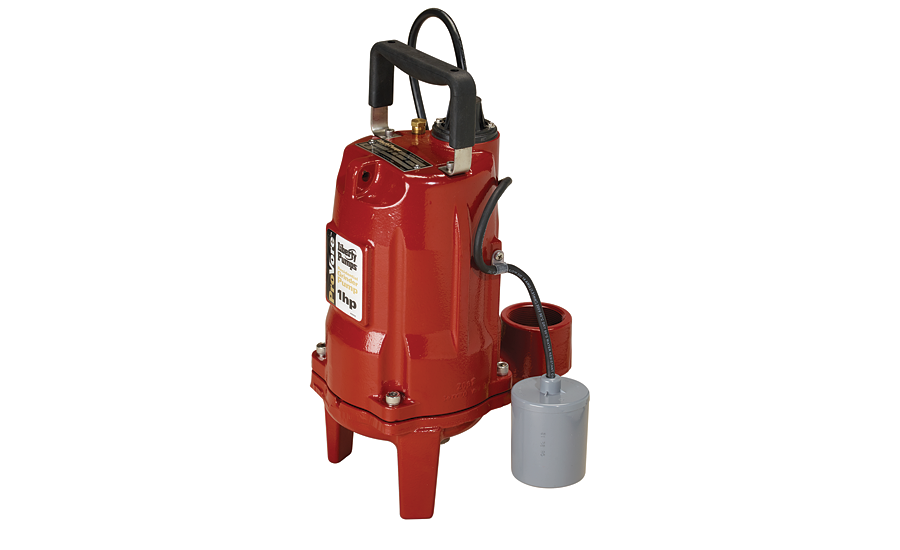Is a grinder pump the right solution for the job?
Since 2009, wastewater treatment officials across the country have seen a rising tide of sewer backups, pump break downs and overflows caused by sanitary wipes

Grinder sewage pumps use steel blades to cut and grind human waste and other material that a conventional plumbing system might struggle to handle into a liquid slurry for easy evacuation down the sewer drainage system. Pictured is Ryan Hendershott, a licensed plumber with Schreiner & Sons, with Saniflo’s Sanibest Pro heavy-duty grinding system.
Photo credit: Joseph Hilliard

Grinder sewage pump technology keeps changing to provide better efficiency for sewage systems. Liberty’s ProVore residential grinder (pictured) features a 1-horsepower motor and lower amps. Grinder pumps with lower-horsepower motors are ideal for residential retrofit applications.
Photo credit: Liberty Pumps


Since 2009, wastewater treatment officials across the country have seen a rising tide of sewer backups, pump break downs and overflows caused by sanitary wipes that are marketed by companies as “flushable.” For example, Onondaga County, N.Y.’s, Department of Water Environment Protection responds to more than 4,000 trouble calls and service requests from homeowners and businesses having trouble with their sewers every year — noting that 1,500 calls a year are for piping systems clogged by so-called flushable wipes, reports Syracuse.com.
With the increased usage of these wipes added to the list of hygiene products that get flushed down the toilet, the plumbing industry needed to do something to avoid the constant clogging of plumbing systems as well as help city sewage treatment systems. With research and development, plumbing manufacturers came up with the grinder pump.
Grinder sewage pumps are exactly what the name implies. Unlike a regular pump, which pumps out what flows in, a grinder pump applies the use of steel blades to cut and grind human waste. Other residuals are flushed down the toilet system or through other fixtures connected to the pump. The liquid slurry is then pumped out through a small diameter pipe.
“Anything we can limit going into the toilet is preferred, but it is not feasible to expect flushable wipes to vanish from use,” says Scott Stayton, director of portfolio management at Franklin Electric/Little Giant. “A grinder with an efficient cutter can handle the wipes with no issue. Sewage pumps can handle the wipes in most cases and those pumps with a vortex impeller perform a little better. However, other items that find their way into a toilet — Swiffer wipes, rubber gloves and other household cleaning items — can test a system. A well-designed grinder can handle these items and continue providing service.”
Bo Gell, product manager at Xylem Applied Water System, agrees: “Grinder pumps are a good choice if flushable wipes are present in the wastewater stream; they can help move flushable wipes to the larger sewer system if used in a properly designed system, but they are not bandages for a clogging system. Older sewage pumps were never designed to handle flushable wipes. When flushable wipes cause clogs, the only way to fix them is to remove them from the system. Grinders are effective in this situation only for clog prevention, not removal.”
Most grinder pumps are designed to operate with traditional centrifugal pump characteristics, using a volute and impeller to create the pumping action. The grinding mechanism is added to the intake side of the volute to shred and macerate solids found in sewage to a slurry for passage through the pump chamber (volute/impeller). Also in the market are positive displacement-style grinder pumps, which still use the cutting mechanism on the intake, but the pumping action is different and results in different pump performance or capabilities.
The main difference between a regular sewage pump and a grinder pump is the cutter or grinder mechanism prior to the intake.
“Low-pressure sewer applications require higher heads, or pressure, for the applications, which call for impeller and volute design differences,” Stayton explains. “This results in tighter clearances between the components and typically results in shorter impeller vane heights. In a standard sewage pump, the volute clearances have the ability to pass 2-inch solids, where a grinder creates a slurry of material. A sewage pump tends to provide more capacity for the same horsepower range vs. a grinder pump. It is a trade-off between pressure and flow.”
Although grinder pumps have been around for more than 30 years, new technology allows for an increase in popularity. “It’s not as large an investment as it was before,” notes Jose Pachas, technical manager at Saniflo. “If you compare the pricing of a sewage ejector pump vs. a grinder system, the difference is not as high as it used to be. It’s not an out-of-pocket reach and it’s definitely a lot more affordable for an end user.”
The reverse could be said as well — the main driver with grinder pump technology is popularity itself. “Grinders are being used more and more, therefore more manufacturers are competing for share,” Stayton says. “The competition is driving the technology to design better cutters, more horsepower ranges and accessories.”
The pump materials themselves are a primary trend focus. “Traditionally, grinder pumps are constructed of cast iron and are oil-filled,” Gell says. “We are researching and developing new casing materials to improve efficiency and performance. Another industry trend is a redesign of cutter technology, which will make grinder pumps capable of processing larger and tougher types of waste discharge.”
Randall Waldron, Liberty Pumps’ vice president of sales and marketing, agrees: “Many manufacturers have improved their cutting designs, resulting in better grinding and less jamming on difficult materials. This also reduces the potential load on the pump and can result in less electrical usage or lower amp draw. Another trend is lower horsepower motors, allowing these pumps to be easily installed or retrofitted into existing residential installations.”
A well-designed product will take advantage of both function and efficiency. “The motors used with centrifugal grinder pumps are very similar to that of other sewage ejector pumps and follow the same rules for efficiency,” Stayton says. “While there are improved motors for energy efficiency, the grinding capability and cutting mechanism can limit the flexibility in pump design. Simply stated, it takes power to grind and lower power can create risk of a complete cut of material and successful pumping of the slurry.”
Retrofit vs. new construction
Whether to use a grinder pump in a particular application depends on what makes up the wastewater stream, where the pump will be used and at what part of the sewage stream it will be installed. In cases of retrofit vs. new installations, the trend of grinder pumps is prevalent in both.
“In retrofits, we have customers who have many problems with clogging and they’re looking for a solution,” Pachas says. “They do their homework and come to us asking for a grinder pump. Of course, if it is a retrofit, it’s going to be a little more difficult because you may have to do some sort of rearranging through the whole application.”
He adds that Saniflo receives more requests for grinder pumps in new installations because building owners and contractors don’t want to worry about maintenance issues in the future.
Grinders are typically found in low-pressure sewer applications, such as a community of homes or a business where gravity sewage is not practical or possible.
“With a grinder, you can pump the wastewater through smaller-diameter pipe due to the fine particles and pressure produced by the pump,” Stayton notes. “This allows for lower installation costs for a community as opposed to a gravity sewage system that calls for larger-diameter pipe and invasive trenching to create a rise or drop for sewage flow over the length of the point-to-point pipelines.”
A sewage pump may be required where more capacity or flow is demanded, he adds. It comes down to the specific application, design parameters and, in some cases, the specifying engineer or contractor preference. The key, he says, is to make sure the system is sized properly and can be maintained or serviced long-term.
Many grinder sewage pump manufacturers offer factory and onsite training for contractors to ensure they are installing such pumps correctly and in the proper installations.
“Contractors should do their research,” Stayton says. “Understand the pump performances and where the pump will actually operate on the performance curve in the installation. Simply looking at the maximum pressure or full flow a pump can produce is not where the pump will actually operate or perform in the application. Additionally, contractors should understand how a grinder works and the application. Grinders tend to get misapplied as a ‘fix-all’ to a problematic installation.”
This article was originally titled “To grind or not to grind” in the July 2016 print edition of Plumbing & Mechanical.
Looking for a reprint of this article?
From high-res PDFs to custom plaques, order your copy today!












